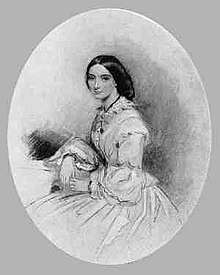Edward Daniel Stone
Edward Daniel Stone (1832 – September 17, 1916) was an ordained deacon, classical scholar and a schoolmaster at Eton College.
Early life
He was the son of Lucia Catherine Stone (née Roswell) and Joseph Stone, who worked in Dorchester, Dorset as the town clerk.[1] His siblings were Walter George Boswell Stone, an antiquarian; William Harry Stone, and Edith Stone.[2]
He attended Eton College beginning in 1845 and in 1856 he received a BA from King's College, Cambridge. Three years later he received his Masters' degree at Cambridge.[3][4] From 1855 until 1862, he was a Fellow of King's. In 1860, he was ordained a deacon of the Church of England.[1][3]
Career
Educator
Beginning in 1857, he was assistant master at Eton, a position he held for about 27 years.[3][4] His students included Sir Henry Babington Smith and Sir Evelyn Ruggles-Brise.[1] On November 20, 1873, he was admitted into the Chemical Society.[5]
Reilly stated that in 1884, he established a school in Broadstairs, Kent in Stone House and operated the school until 1895.[3][1][lower-alpha 1] Stone moved to Abingdon, Berkshire after retirement in 1898, living with his son Rev. Francis Joseph (Frank) Stone, who was the Science Master at Radley College.[1][7]
Author
He was the author of The Field of Rivalry: An Heroic Poem, in four books, written in the 1850s.[3] Stone published Dorica, a volume of poems, four of which were in Dorset dialect. The volume was inspired by poet William Barnes.[8] In 1912, Stone published Herbert Kynaston: A Short Memoir with Selections from His Occasional Writings a memoir of Herbert Kynaston (1809–1878),[9] prebendary of St. Paul's Cathedral and High Master of St Paul's School, London.[10]
Personal life

In August 1861, he married Elizabeth Theresa "Lily" Vidal, the only daughter of the Rev. Francis Furse Vidal and novelist Mary Theresa Vidal (née Johnson). She was born in 1841 in New South Wales[11] and died in 1898.[2]
Their ten children[1] included Lucy, Frank, Ned, Ruth, Mary, Margaret, William Johnson, Guy, Faith, and Christopher.[2] They adopted Nelly Stone.[12]
During his life, Stone corresponded with his son-in-law Compton Mackenzie, Scottish nationalist and writer who married Faith; Robert Bridges, Britain's poet laureate; and A. C. Benson, English author and academic.[2][13]
Stone died on September 17, 1916 in Abingdon, and is buried at Radley in the cemetery in St. Helen's Churchyard.
Works
He was a Greek and Latin scholar. Among others he published:
- The Hannibalian Or Second Punic War, 1881
- Ionides: Exercises in Greek Iambics, 1883
- Selection from the Greek tragedians, 1890
- Tu Es Petrus. An Examination of Two Passages in S. Matthew's Gospel, and of the Doctrine of the Real Presence, 1909
- Florilegium Latinum; Translations Into Latin Verse, with Francis St John Thackeray, 1923
Notes
References
- 1 2 3 4 5 6 "Death of Mr. Stone: Schoolmaster, Poet, and Scholar". The Times. London. November 19, 1916. p. 20 – via newspapers.com. (Subscription required (help)).
- 1 2 3 4 "Edward Daniel Stone Papers". CollectionsOnline Catalogue, Eton College. Retrieved July 26, 2017.
- 1 2 3 4 5 "Catherine Reilly" (2000). Mid-Victorian Poetry, 1860–1879. A&C Black. p. 441.
- 1 2 Eton College (1905). Eton College, Eton School Register Part II (1853-1859). Spottiswood, Privately Printed. p. vi.
- ↑ The Chemical News and Journal of Physical Science, Volume 28. Griffin, Bohn and Company. 1873.
- ↑ Home Beauties: As Communicated to the Author of the Imperial Guide, by Some of the Royal Family, the Nobility, Gentry, &c. for an Illuminated Appendix to that Work. C. Whittingham, printer. 1804. p. 36.
- ↑ Radley College Register 1847 — 1904 (Second ed.). St. Peter's College, Radley. 1905. p. 16.
- ↑ William Barnes (December 2013). Complete Poems of William Barnes: Volume I: Poems in the Broad Form of the Dorset Dialect. OUP Oxford. p. lxxvi. ISBN 978-0-19-956752-2.
- ↑ Edward Daniel Stone (September 2010). Herbert Kynaston: A Short Memoir with Selections from His Occasional Writings (1912). Kessinger Publishing. ISBN 978-1-164-22458-7.
- ↑

- ↑ J. C. Horner (1967). "Vidal, Mary Theresa (1815–1873)". Australian Dictionary of Biography, National Centre of Biography, Australian National University. Retrieved July 27, 2017.
- ↑ Faith Compton Mackenzie (1938). As Much As I Dare - An autobiography. Collins 48 Pall Mall, London. p. 100-111.
- ↑ Robert Seymour Bridges and Lionel Muirhead (1984). The Selected Letters of Robert Bridges: With the Correspondence of Robert Bridges and Lionel Muirhead, Volume 2. University of Delaware Press.